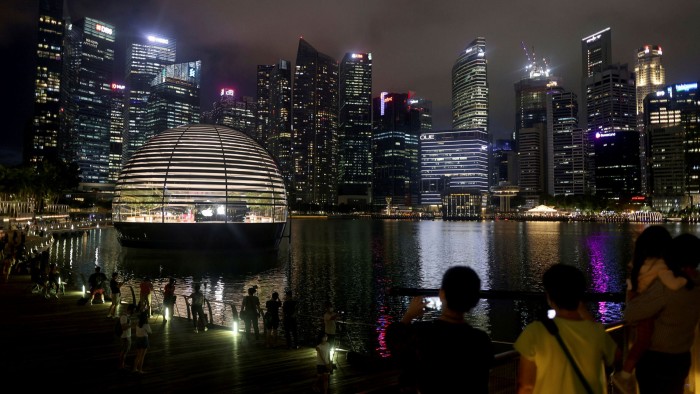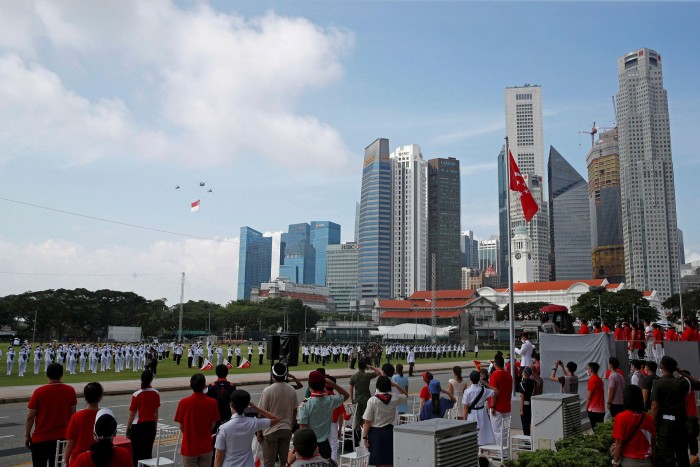Singapore charts its way to digital future for trade

Roula Khalaf, Editor of the FT, selects her favourite stories in this weekly newsletter.
Singapore’s August 9 national day event — usually marked by parades, musical shows and Air Force fly-pasts — was slimmed down this year due to Covid-19: for the first time, Singaporeans were treated to a “digitalised and immersive experience” beamed directly into their homes.
The multimedia project, which utilised augmented reality technology, highlighted the creativity and innovation that will be required on a greater scale by the south-east Asian nation as it charts its way towards a different, digital future.
Although its location has fuelled Singapore’s evolution into a vibrant Asian trading entrepôt, its reliance on global trade flows have exposed the city-state’s vulnerability to the pandemic’s economic shock.
Lee Hsien Loong, Singapore’s prime minister, said in August the economy would shrink as much as 7 per cent this year — its worst contraction in the nation’s 55-year history. “We will not be returning to the open and connected global economy we had before any time soon,” he said.
Noting that Singapore had become successful by “connecting ourselves with the world”, Mr Lee said that while global trade flows would be diverted or even dry up, new channels would arise, requiring the country to “prepare for a very different future”.
Singapore’s policymakers see digitalisation of trade as one way to do this, taking advantage of the increasing adoption of ecommerce; the use of digital technology by banks in trade finance; and the provision of other cross-border services through mobile apps and other platforms.
Shortly before the pandemic struck, Singapore had forged new trading relationships — known as digital economy agreements (DEAs) — with Australia, New Zealand and Chile. These mapped out how the country sees digital trade working in practice.

The DEAs aim to align uniform digital rules and standards, while facilitating interoperability between digital systems, supporting cross-border data flows and encouraging co-operation in digital identities, artificial intelligence and data innovation.
Given Singapore’s position as Asia’s largest ship bunkering port and also biggest commodities trading hub, there are obvious synergies that point to the city-state’s potential as a digital trade ecosystem with influence far beyond its shores.
Contour is a company set up last year in Singapore that uses digital technology to simplify trade finance, including using blockchain technology to digitalise letters of credit — staples of trade financing that have long relied on paper documentation.
Carl Wegner, chief executive, says the company — whose investors include banks Citigroup, Standard Chartered, Bangkok Bank and DBS — chose Singapore as its base in part because “there is a considerable amount of trade finance happening through Singapore that does not necessarily physically touch the country’s shores”.
Longer term, Singapore is working on a project called TradeTrust that aims to develop an “interoperability framework” for the exchange of digital trade documentation that would simplify and speed up procedures.
“Our future is in bits and bytes, submarine cables and data, not just in shipping containers,” is how one senior Singapore official explains it. The ultimate objective is to work with other countries to accelerate digital innovation in trade globally.
The developments have attracted the attention of other countries keen to exploit ways to generate new digital and physical trading relationships in a world where deglobalisation, US-China trade tensions and Brexit are disrupting supply chains.
Natalie Black, the UK’s Singapore-based Trade Commissioner for Asia-Pacific, says that while the economies of the Association of Southeast Asian Nations (Asean) — the 10-country bloc of which Singapore is a member — have suffered amid the global downturn, many remain relatively robust. She says the pace of digital adoption among their populations, as well as the growth of ecommerce, remain impressive.
“We think the future is in this part of the world not just because of the growth figures but because of how trade will be conducted. The work that Singapore has done across the region on digital trade can teach us a lot,” Ms Black says.
British efforts to tap into the region’s digital ecosystem come in the form of a “digital trade network”, which launched in June and aims to help UK tech companies break into the region. Backed by £8m in government funding and involving Tech Nation — a government-backed organisation supporting UK entrepreneurs — the scheme will start in Singapore, Australia and Japan.
Chan Chun Sing, Singapore’s minister for trade and industry, said recently that further trading opportunities should come from the anticipated signing of the Regional Comprehensive Economic Partnership (RCEP), a proposed trade agreement that encompasses the 10 Asean member states, as well as Australia, China, Japan, New Zealand and South Korea.
“We will work to stay connected with the world, even as the world threatens to fragment and regress towards protectionism,” he said. “Despite our size, we can show the way, if we have good ideas.”

Comments